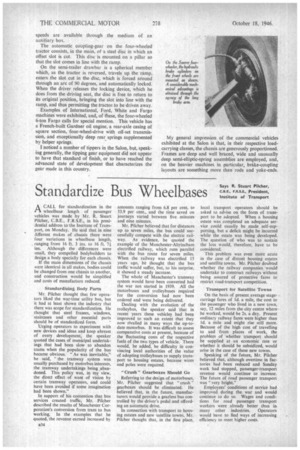Standardize Bus Wheelbases
Page 40

If you've noticed an error in this article please click here to report it so we can fix it.
ACALL for standardization in the wheelbase length of passenger vehicles was made by Mr. R. Stuart Pitcher, C.B.E. F.R.S.E., in his presidential address toihe Institute of Transport, on Monday. He said that in nine different makes of chassis there were four variations in wheelbase length, ranging from 16 ft. 3 ins, to 16 ft. 7i ins. Although the differences were ;mall, they compelled bodybuilders to design a body specially for each chassis.
If the main dimensions of the chassis were identical in all makes, bodies could be changed from one chassis to another. and construction would be simplified and costs of manufacture reduced.
Standardizing Body Parts Mr. Pitcher thought that few operators liked the war-time utility bus, but it had at least shown the industry that there was scope for standardization. He thought that steel frames, windows, staircases and other essential parts should be of standardized form.
Urging operators to experiment with new devices and ideas and keep abreast of every development, the speaker quoted the cases of municipal undertakings that had been slow to abandon trams when the popularity of the bus became obvious. "As was inevitable," he said, "the tramway system was usually purchased by motorbus interests, the tramway undertakings being abandoned. This policy was, in my view, the direct effect of want of vision by certain tramway operators, and could have been avoided if some imagination had been shown."
In support of his contention that bus services created traffic, Mr. Pilcher described the results of Manchester Corporation's conversion from tram to bus working. In the examples that he quoted, the revenue earned increased by
amounts ranging from 6.8 per cent. to 53.9 per cent., and the time saved on journeys varied between five minutes and nine minutes.
Mr. Pitcher believed that for distances up to seven miles, the bus could successfully compete with the electric railway. As evidence, he quoted the example of the Manchester-Altrincham electrified railway, which runs parallel with the bus route for seven miles. When the railway was electrified 15 years ago, he thought that the bus traffic would suffer, but, to his surprise, it showed a steady increase.
The whole of Manchester's tramway system would have been converted had the war not started in 1939. All the inotorbuses and trolleybuses required for the conversion had now been ordered and were being delivered.
Dealing with the evolution of the trolleybus, the speaker said that in recent years these vehicles had been improved to such an extent that they now rivalled in many ways the up-todate motorbus. It was difficult to assess comparative costs at present, because of the fluctuating costs of the respective fuels of the two types of vehicle. There would, he added, be difficulty in convincing local authorities of the value of adopting trolleybuses to supply transport to housing estates, because wires and poles were required.
"Crash" Gearboxes Should Go Referring to the design of motorbuses, Mr. Pitcher suggested that " crash " gearboxes should be eliminated. He believed that, in the future, manufacturers would provide a gearless bus controlled by the driver's pedal and affording an automatic drive.
In connection with transport to housing estates and new satellite towns, Mr. Pitcher thought that, in the first place,
local transport operators should be asked to advise on the form of transport to be adopted. When a housing estate was completed an adequate service could usually be made self-supporting, but a deficit might be incurred while the estate was being developed. The question of who was to sustain the loss would, therefore, have to be considered.
This problem was even more acute in the case of distant housing estates and satellite towns. Mr. Pitcher doubted whether the railway companies would undertake to construct railways without being assured of protective fares to restrict road-transport competition.
Transport for Satellite Towns On the basis of present average stagecarriage fares of Id. a mile, the cost to the passenger who lived in a new town, say, 12 miles from the city centre where he worked, would be 2s. a day. Present ordinary railway fares were higher than 1d. a mile and might rise still more. Because of the high cost of travelling to and from places of work, the problem of whether transport should be supplied at an economic rate or whether it should be subsidized, would arise in the case of these new towns.
Speaking of the future, Mr. Filcher believed that, although overtime in factories had been reduced and Sunday work had stopped, passenger-transport revenue would continue to increase. The future of road passenger transport was " very bright."
Employees' conditions of service had improved during the war and would continue to do so. Wages and conditions for road passenger transport workers were already better than in many other industries. Operators would have to find ways of increasing efficiency to meet higher costs.












































































